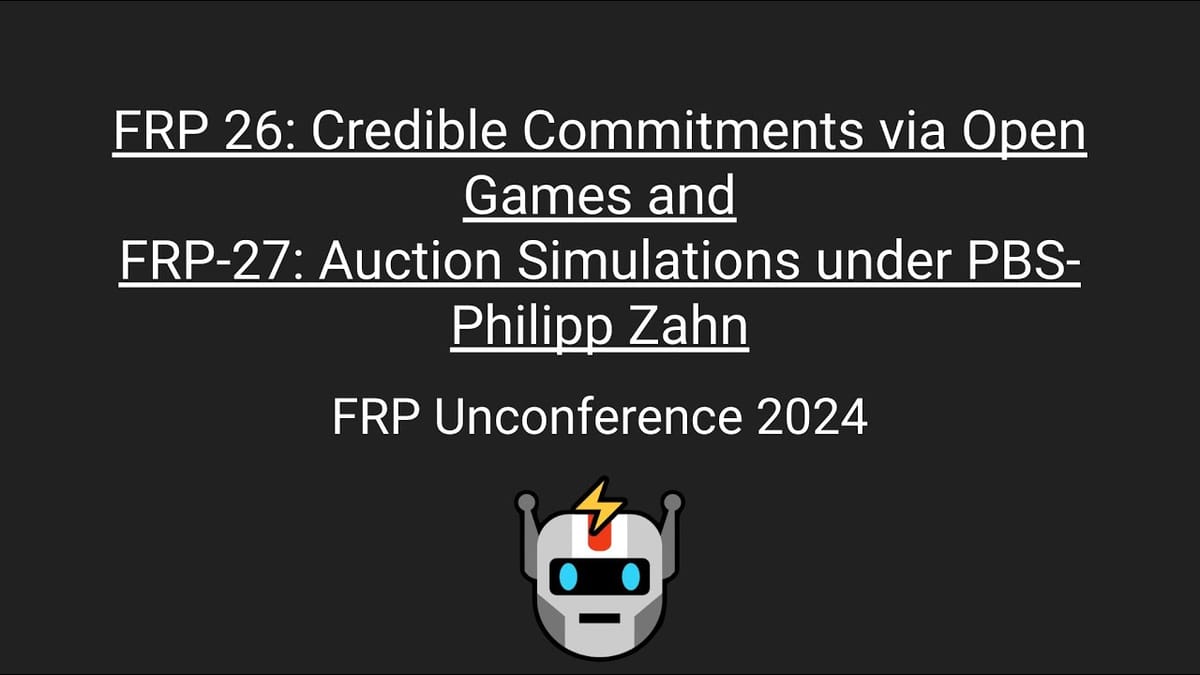Credible Commitments + Auction simulations under PBS
Source : https://www.youtube.com/watch?v=-NGMXHgGQMM

What is compositional game theory ?



Both FRPs introduced here are implemented using compositional game theory, but what is it ?
This is a new mathematical language for analyzing games and strategic situations. The key feature is we can break down large games into smaller "sub-games" and then systematically combine them.
Each sub-game has a basic structure:
- Information comes in from the past
- The game makes a move (outputs information)
- The environment provides a result
- The game reasons about the results and can send new information into the past
we can combine sub-games in two main ways:
- Sequentially - Game A happens first, then Game B happens second, combining into one overall game.
- In Parallel - Game A and Game B happen simultaneously, interacting with each other as part of the same overall game.
With all this, we can reason about the overall strategic situation.
FRP26 : Credible Commitments via Open Games (1:50)

This research looked at how "credible commitments" in strategic situations can change the outcomes.
A credible commitment is when the players lock themselves into following through on a certain action. It makes their commitment believable/credible.
Classical Example with Prisoner's Dilemma :
- Normally players have incentive to "defect"
- If one player can make a credible commitment to "cooperate", it shifts the incentives - now both players will cooperate
Now, what if players use commitments strategically to extract value ? To answer this, we consider a third player which coordinates commitments to benefit themselves
The research shown that commitments change behaviors and value distribution, and modeling this formally helps understand possible effects.
FRP27 : Auction simulations under Proposer-Builder Separation (4:25)

Proposer-Builder Separation (PBS) resulted in complex, evolving market with many players interacting : users, searchers, builders, relays etc...Ans it keeps changing as new players/services enter
So FRP27 :
- Focuses on effects of different auction types across this PBS market
- Models a simple version with relays and builders running auctions for users
- Compares different auction formats
Research shows that :
- Auction format affects user bidding behavior & overall outcomes
- Users must reason about full vertical structure when bidding because auction format has ripple effects across the vertical market
Beyond FRP27 - A generalized model (7:30)


The initial FRP 27 model was basic : 1 relay, 2 builders, some users. So this motivated a more general and reusable model :
- Template agent that is both auctioneer and bidder
- Takes inputs and gives outputs
- Internal logic for valuation and auction choices
In the new model, some builders are in the middle again, but there are more components like users, proposers...And they all interact through standardized interfaces. Hence, we can analyze overall ecosystem incentives by swapping pieces
How is this useful ? (9:30)


With the generalized model, we can quickly set up and analyze different configurations, and swap components to represent different players and incentives. We can study questions like :
- What transactions do users submit, all relays or a subset ?
- If relays specialize with different mechanisms, how does it affect outcomes ?
- If there are multiple mechanisms in parallel, how do they interact ?
- What is the effect of mechanisms like censorship ?
So the basic FRP research led to an extended framework for formally studying these kinds of questions about complex incentive structures.